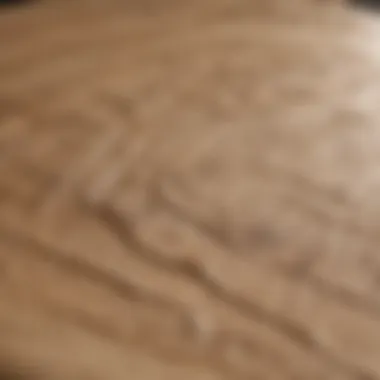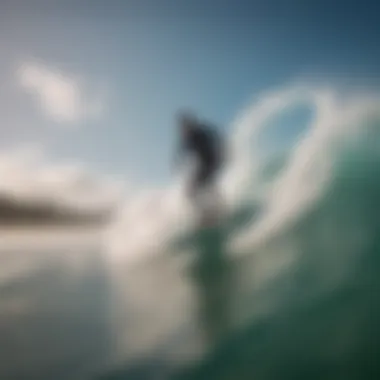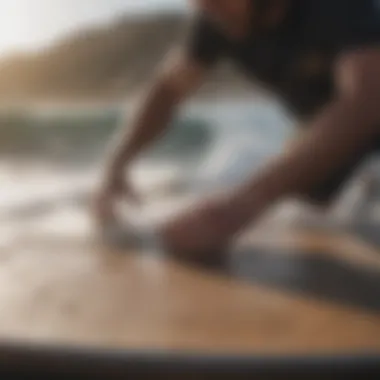The Ultimate Guide to Understanding Swell Boards


Intro
In the world of extreme sports, equipment sets the tone for performance and enjoyment. Kitesurfing relies on multiple components working together, and among these, swell boards hold a prominent position. Understanding these boards is essential for any kitesurfer or kiteboarder seeking to elevate their experience on the water.
Swell boards are designed uniquely to enhance overall riding style, particularly in wave conditions. Different from traditional kiteboards, these specialized boards enable riders to harness the ocean’s swells more effectively.
In this guide, we will explore the many facets of swell boards. We will discuss their design features, key advantages, and the conditions where they excel. Furthermore, we will cover how to maintain these boards, offer purchase recommendations, and examine how they adapt to various riding styles. Get ready to enhance your kitesurfing knowledge and skills significantly.
Equipment Reviews
When it comes to kitesurfing gear, the importance of the right equipment cannot be emphasized enough. In this section, we will delve into critical components that compliment swell boards and overall kiteboarding performance. Understanding these variances can lead to better decisions when it comes to material selection and riding techniques.
Kites
Kites are crucial to kitesurfing. Here, we’ll take a closer look at some of the latest kite models currently available.
- Naish Boost: Known for its high performance in various wind conditions. It offers excellent lift and stability.
- Cabrinha Switchblade: This is one of the versatile kites aimed at different skill levels. Comes with customizable features to fit rider needs.
- Slingshot RPM: A favorite among freestyle riders. The design supports better control and easy maneuverability.
Kite Shapes and Sizes
Different kites come in various shapes and sizes, impacting the flight experience:
- Delta shape: Offers stability across a wide range of wind conditions.
- C-shape: Often preferred for performance in tricks and jumps; requires more skill.
- Sizes: Usually indicated in meters – larger kites are suitable for lighter winds, smaller for stronger winds.
Boards
Swell boards belong to a category of kiteboarding boards, similar but distinct from other options like twintip and directional boards. Here’s what differentiates them:
- Directional Boards: Specifically designed for wave riding, allowing for better control on ocean swells.
- Construction: Many modern swell boards feature lightweight materials to aid in speed and control. They focus on maintaining a high performance while ensuring buoyancy in surf conditions.
- Riding Style Suitability: Those preferring maneuverability might lean more toward swell boards, while speed enthusiasts might choose boards known for their stiffness and pop.
Accessories
The right accessories significantly complement swell boards and enhance the overall experience. Here are some essential accessories you should consider:
- Harnesses: Critical for comfort and efficient load distribution during rides.
- Lines: Check line durability, as they impact kite control.
- Pumps: Quality pumps draw in air efficiently; the faster you set up, the better.
- Safety Gear: All riders should have impact vests and helmets as safety precautions. They protect from potential falls and ocean impacts.
In summary, it's vital to choose the right gear tailored to both individual skills and environmental factors. This initial understanding directly relates to enhancing the forever-evolving kitesurfing experience.
Understanding Swell Boards
Understanding the nuances of swell boards is crucial for kitesurfers and kiteboarders who rely on specialized equipment to elevate their performance. Swell boards are tailored to specific water conditions and can significantly enhance both speed and agility on the waves. When a rider grasps the distinctive qualities of these boards, they can make informed decisions that elevate their riding experience and effectively adapt their techniques and style.
Definition and Features
Swell boards are distinctively designed boards used primarily in kitesurfing, optimized for specific wave and swell conditions. These boards typically have a shorter length and a broader width compared to more traditional kiteboards. This structure allows for better lift and maintenance of speed while riding. Additionally, most swell boards integrate features like tail shapes that aid maneuverability in the ocean's shifting conditions.
Key features often associated with swell boards include:
- Increased floatation: This allows the board to glide smoothly over the swell.
- Concave or channeled bottoms: These designs help facilitate smoother water flow, enhancing control.
- Straps and pads: Customizable bindings that provide comfort and stability.
- Durable materials: Made from fiberglass, epoxy, and other materials, which ensure longevity against the harsh marine elements.
Understanding these individual aspects can aid riders in making a smart investment when selecting their boards.
Comparison with Traditional Boards


When juxtaposed with traditional boards, the differences become evident in performance and design. Traditional kiteboards are typically longer and narrower.
- Performance: Traditional boards may excel in flat water but lack the specialization required for choppy conditions. Swell boards shine in such environments where wave harnessing is essential.
- Maneuverability: Swell boards' thinner profiles and unique tail designs enable sharper turns and cuts, valuable when navigating through waves.
- Riding Experience: Riders who use swell boards often describe a heightened level of control and responsiveness compared to traditional boards, allowing a seamless connection with the water.
Overall, comprehending the significance of swell boards goes beyond surface-level features. Recognizing their specific characteristics impacts how well a rider may perform under diverse conditions, allowing greater overall enjoyment in the saddle.
The Functionality of Swell Boards
Swell boards are not mere tools for kitesurfing. They carry significant functional advantages that cater specifically to the varied demands of kitesurfers and kiteboarders. Understanding their functionality helps riders enhance their performance and adapt effectively to diverse conditions. In this section, we explore two critical aspects of swell boards: their performance in different conditions and how riders can optimize their techniques according to their unique dynamics.
Performance in Varied Conditions
Swell boards boast unique designs that greatly influence performance under specific environmental variables. Their shape, fin configuration, and overall construction contribute decisively to how they interact with water surfaces and tides.
- Light Winds: The lightweight body of a swell board permits more responsive movements. Riders can leverage slight breezes, enabling dynamic turns and quick navigation. This feature is beneficial for less experienced individuals seeking maintenace supervision in calmer conditions.
- High Wave Conditions: With pronounced rocker and volume, these boards function effectively in larger swells. The elevation reduces submersion during rapid descents, provisioning stability while cutting through the crest of high waves. Proficient riders appreciate how swell boards can maintain speed despite turbulent water conditions.
- Choppy Waters: Many kitesurfing environments feature variable waves. Here, swell boards tend to excel. Their profile promotes buoyancy, easing impact during abrupt water movement, allowing for smoother carving and controlled airtime. Riders report improved balance and confidence, crucial for tactics in such challenging environments.
Important Consideration: An effective comparison should be made between swell boards and traditional boards under different conditions. Understanding distinctions not only assists in choosing appropriate gear but enhancing ride versatility.
Optimizing Riding Techniques
Mastering swell boards requires understanding and applying distinct riding techniques suited to their functionalities. Riders can unlock superior performance with the right approach, enhancing both competency and enjoyment in the experience.
- Weight Distribution: The balance between front and back foot positions significantly impacts control. Riders should experiment with shifting weight to initiate turns or regain balance during speed adjustments.
- Carving: Use the board’s edge to carve through waves. Swell boards are excellent for tight turns, and practice on this can yield superior maneuverability. The trick involves digging the edge while maintaining fluid motion through the turns.
- Timing and Kite Control: Synchronization with your kite's movements is essential. A swell board performs best when the kite generates constant power and stability. Proper timing ensures appropriate boost levels and optimal wind usage. Riding in unison enables riders to maintain higher speeds without sacrificing control.
- Practicing in Varied Environments: Engaging in different water states always enhances one's adaptability. Riding from windswept, small waves to large ocean swells develops adaptive responses that improve overall kitesurfing abilities. Understanding how to adjust technique instantly based on real-time conditions is key for experienced riders.
Overall, swell boards offer specialized features that maximize performance when riding. Mastering the functional benefits and related techniques ensures subfusc wou enjoy maximum efficacy while kitesurfing in various condiitons.
Swell Board Design Considerations
Design considerations play a crucial role in the performance and functionality of swell boards. Understanding materials, size, and shape can significantly impact how a swell board behaves during kitesurfing or kiteboarding. A well-designed swell board enhances user experience and maximizes performance in various conditions. Focusing on these design elements enables riders to select the appropriate equipment relative to their capability, type of riding, and specific environmental conditions.
Materials and Construction
The materials and construction of a swell board affect its durability, weight, and overall performance. Most swell boards utilize high-quality materials such as fiberglass or carbon fiber, which contribute to their strength and lightness. Epoxy resin is a popular choice for construction as it offers excellent torsional rigidity and responsiveness. Moreover, these materials enable the boards to flex properly, thus providing the necessary balance between performance and comfort on water. Careful choice of materials can significantly extend the unit's lifespan and reduce maintenance needs.
Size and Shape Variations
When it comes to swell boards, size and shape are not merely matters of aesthetics. These variations directly influence the board's performance on water. Understanding these aspects is essential for riders aiming to fine-tune their surfing experience.
Length Considerations
Length considerations are fundamental when selecting a swell board. Generally, longer boards provide better flotation, making them suitable for lighter winds and larger swell. A longer surfboard can excel in wave catching and offers more stability, especially for beginners. Conversely, shorter boards are typically more maneuverable but require more skill to maintain balanced riding. Therefore, long length is often seen as a beneficial choice for varied climatic conditions, allowing better adaptation.
Width Dimensions
Width dimensions further define the stability of a swell board. A wider board offers increased stability, ideal for rough conditions or choppy waters. Meanwhile, narrower boards enable greater speed and agility; they are more favorable for experienced riders looking to perform advanced tricks. The increased buoyancy of wider boards enables comfortable riding, while the swift maneuverability of narrow boards enhances performance. Hence, choosing the right width is an important factor to achieve the desired balance.
Tail Shapes
Tail shapes play a pivotal role in how a swell board interacts with the water. Different tail designs, such as fish tails or square tails, affect lift and control. For instance, a rounded tail can provide smooth ride and fluidity, ideal for choppy conditions, while a square tail may enhance grip and agility. Each tail shape contributes unique performance aspects, allowing riders to better understand and adapt their technique.
Knowing the intricacies of each tail can help riders select based on their personal style and conditions faced on the water.
Choosing the Right Swell Board


Selecting the right swell board is essential for optimizing one’s experience in kitesurfing. Choosing a swell board involves various considerations that can significantly impact performance and enjoyment. It is not solely about picking a board that looks appealing; it's more about finding a board that complements the rider's skills and meets particular environmental demands. Potential kitesurfers should thoughtfully examine factors such as their skill level, the tidal conditions, and personal preferences.
Factors to Consider
Rider Skill Level
Understanding your rider skill level is a crucial aspect when choosing a swell board. A board that matches one's skill capability can enhance control, stability, and confidence on the water. An advanced kitesurfer might seek a lightweight, responsive board that allows for quick maneuvers, while a beginner may benefit from a more forgiving, balanced board that offers stability and easier steering.
Key Features of rider skill level considerations include:
- Experience: The skill level impacts how one interacts with various board designs.
- Improvement Potential: Ontop of skill, the desire for improvement also shapes your choice. More advanced boards may help sharpen skills.
Disadvantages of misjudging skill level can lead to frustration. Newer riders using a complex board could feel overwhelmed.
Tidal Conditions
Tidal conditions play a significant role in the performance of swell boards. Different boards are responsive to various environments. For example, surfboards may perform very well in smaller, punchy waves, while flat-water boards excel on smooth surfaces. Thus, understanding tidal moods can guide the right choice of gear.
Key Points regarding tidal conditions include:
- Wave Size: Smaller boards offer agility in choppy water, but large summer waves require longer, deeper boards for stability.
- Water Currents: Picking boards that adjust well to fishing currents is essential.
On the downside, neglecting tidal conditions can hinder performance expectations and riding experiences. Riders should assess local conditions regularly.
Personal Preferences
Every rider has unique preferences that heavily influence the selection of swell boards. Some may prioritize speed, while others focus on stability or maneuverability. Knowing personal inclinations helps in making a suitable choice.
Notable aspects about personal preferences include:
- Riding Style: Whether someone prefers freestyle tricks or pushing moves can alter board specifications.
- Design Aesthetic: While not performance-driven, the visual appeal and style of the board can impact user connect and confidence.
Nonetheless, fixating purely on aesthetics may detract from functional decisions. Balancing personal desire with performance traits is key to success in kitesurfing.
Top Brands in the Market
Understanding the offerings in the swell board market can guide optimal choices for kitesurfing gear. Several leading brands consistently produce high-quality boards matched for durability and various consumer needs. Some notable brands are:
- Naish: Known for innovative designs and reliable performance.
- F-One: Excels with boards that cater for performance as well as leisure.
- Cabrinha: Offers a diverse range, known for stability and high-quality build.
- Duotone: Balances competitive performance with market trends.
Careful research into different brands can help to align purchase decisions with personal values and specific requirements.
Maintenance and Care of Swell Boards
Maintaining and caring for swell boards is crucial for prolonging their lifespan and ensuring their optimal perforance. Swell boards endure notable wear and tear from various factors such as water, sun, and rough surfaces encountered in the kiting environment. Proper care reflects a deep commitment to performance and safety, ultimately improving the experience on the water. This section focuses on practical techniques and routine checks necessary to keep your swell board performing at its best.
Regular Cleaning Techniques
Cleaning swell boards requires deliberate attention to detail. Regular maintenance help prevent damage and ensures consistent riding performance. Here are some effective cleaning techniques:
- Fresh Water Rinse: After every kiting session, rinse your board with fresh water to remove salt, sand, or grime. Salt can corrode the surface over time.
- Soft Cloth Cleaning: Use a soft, non-abrasive cloth to gently wipe any stubborn stains or dirt from the surface. Avoid using rough materials which can scratch.
- Foam Cleaner: For deeper cleaning, consider using a specific foam cleaner designed for swell boards. Ensure it is safe for the materials used in your board's construction.
- Drying: After washing, let the board air dry before storing. Storing the board while wet can lead to mildew or damage to any graphics or prints.
By adhering to these cleaning practices, you will not only extend your board's life but enhance its responsiveness.


Keeping your swell board clean enhances its longevity and performance, offering a smoother experience during rides.
Inspecting for Wear and Tear
Frequent inspection for wear and tear plays an essential role in maintenance. Early detection prevents minor issues from evolving into major problems. Conduct the following checks regularly:
- Visual Inspections: Look for any visible cracks, dents or scratches on the board surface. Addressing these before they worsen can avoid costly repairs.
- Fin Checks: Check the fins for any damage or loosening. Ensure they are properly secured, as loose fins can alter the board’s performance.
- Attachment Points: Inspect connection points of any foot straps or bindings. A loose attachment can cause accidents during riding.
- Glossy Coating: Maintain an eye on any markings or wear on glossy coatings. If it starts to discolor, it may indicate damage underneath that needs addressing.
Addressing wear and tear issues proactively ensures that your swell board continues to deliver the performance you expect. Regular inspections can help reveal potential long-term problems while ensuring your cautious approach to safety and enjoyment in kiting unveils its advantages on the water.
Impact of Swell Boards on Riding Style
Swell boards directly affect the riding style of kitesurfers. These boards are specifically designed to enhance performance and provide tailored experiences in swell. Understanding this impact is crucial for athletes who wish to optimize their sessions and embrace varying conditions.
Influencing Performance
The performance of a rider is significantly influenced by the choice of board. Swell boards are engineered to glide efficiently over the water, providing improved speed and maneuverability. This enhances acceleration and allows for sharper turns, which are essential when navigating through rolling waves.
Moreover, the unique buoyancy and design of swell boards enable surfers to maintain ride even in less-than-ideal conditions. Consequently, they can execute more complex tricks and innovations in their style, taking full advantage of available wave sets.
For kitesurfers aiming to compete or improve their skills, integrating swell boards into their riding offers notable advantages. Some key aspects to consider include:
- Control: The added grip allows for better handling, especially during high-speed maneuvers.
- Lift: Enhanced buoyancy means less effort is required, enabling prolonged sessions without fatigue.
- Versatility: It delivers performance in various conditions, from gentle swells to powerful waves.
Adapting to Conditions
Different kitesurfing conditions demand distinct approaches. Swell boards enable riders to adapt their technique effectively. As wave size and wind direction change, riding style can also evolve. This adaptability may allow riders to harness energy from the swells effortlessly.
When kitesurfers utilize swell boards, they become attuned to environmental variations more rapidly, shifting their weight and position as needed. Success depends on these quick adjustments.
Key factors influencing adaptability include:
- Wave Height: Tall swells might require different board characteristics for optimal surfing compared to small waves.
- Water Texture: Understanding how to react to rough surface vs calm smooth surface can define an athlete's skill level.
- Wind Strength: The power of the wind can change the requirements for balance and movement, emphasizing why a good surf board can be a crucial part of one’s gear.
"Understanding how swell boards align with riding conditions can drastically improve the kiting experience.”
By becoming proficient in these areas, kitesurfers can better select and use swell boards, ultimately refining their technique and elevating their overall performance.
Future Trends in Swell Board Design
Future trends in swell board design hold significant importance for kitesurfers and kiteboarders aiming to enhance their experience on the water. As technology advances and user preferences change, makers must adapt their products to meet the evolving demands of extreme sports enthusiasts. A focus on unique design elements, innovative materials, and user input is crucial to maintaining competitive advantage in this niche market. This section delves into necessary shifts in design and production.
Innovative Materials and Technology
In today's market, material selection paramountely affects the performance of swell boards. Modern technologies have introduced lighter, more durable options. For instance, carbon fiber and composite materials provide a significant weight reduction without sacrificing strength. These advancements optimize buoyancy. Moreover, innovative technologies are being implemented in the shapes and profiles of boards. Specific designs enhance maneuverability and speed.
Other technological trends include improved fin systems and straps, providing better grip and control. 3D printing is also impacting manufacturing processes, allowing for more precise designs tailored to user preferences. This customization aligns with the kitesurfer's style. It ensures excellent performance in varying conditions.
To summarize, employing futuristic materials coupled with precise technology is essential for better performance in swell board usage.
Shifts in User Preferences
Changes in user preferences are shaping the future of swell board design. Kitesurfers for example tend to favor options that combine practicality and style. Summarized below are key aspects of these shifts:
- Lightweight construction: Many kitesurfers need boards that are easier to transport. Preferences relate directly to the weight and overall sizing of the board.
- Eco-friendly materials: A notable trend is the increase in demand for sustainable materials. Users show growing concern regarding the environmental impact of production methods.
- User customization: Swell board consumers increasingly desire boards tailored to their individual riding styles. Customizations could include adjusting size or shape to enhance personal performance.
Observing shifts in user expectations aids manufacturers to concentrate on innovations involving both material efficiency and customization options. This alignment keeps the experience fresh without severely affecting performance.
The understanding of user preferences defines strategic directions for swell board manufacturers, impacting market competition.
In the end, future trends such as innovative materials and tech advancements must reflect the deserving needs of the user community in the world of kitesurfing and kiteboarding.







